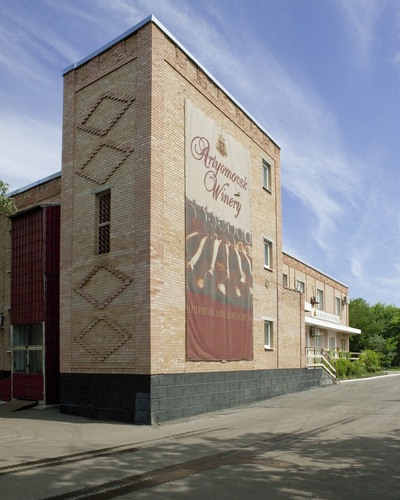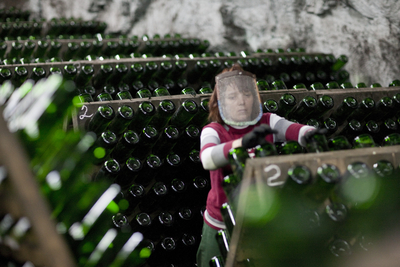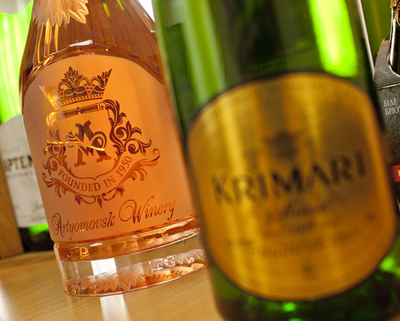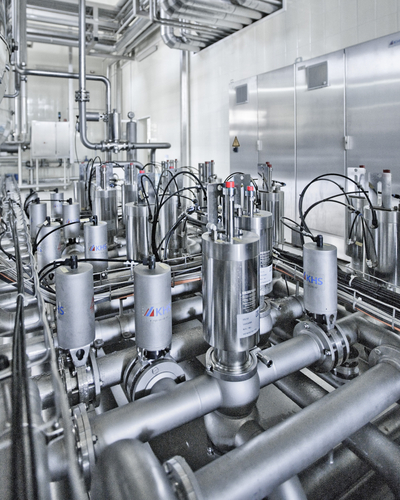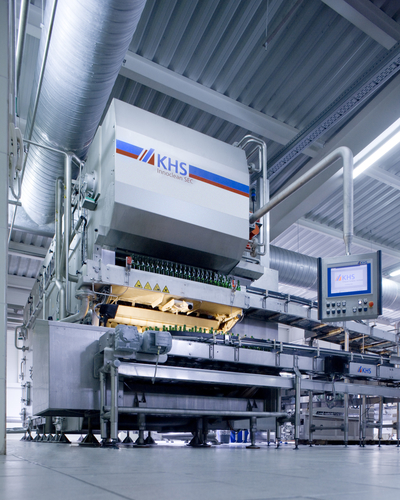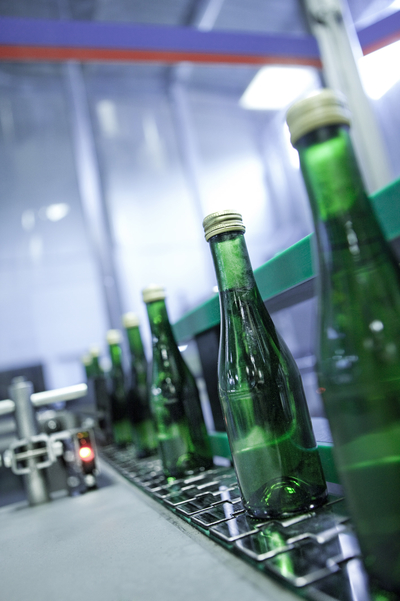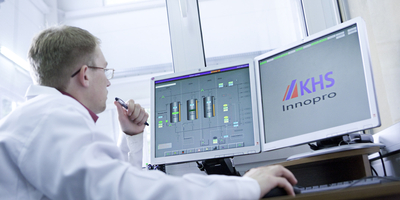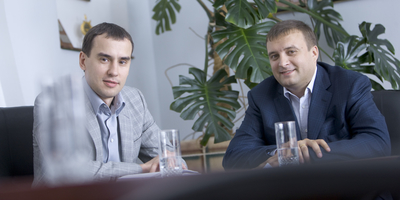
Quality as company philosophy
PAG “Artyomovsk Winery”, the biggest sparkling wine winery in the Ukraine, invests in the KHS all-round solution
Alexander Pismenny* Ludwig Clüsserath** Jaroslaw Niebisch*** “Top quality products require the best possible technical solutions” – a view that Alexis Garkusha, General Director of the Ukrainian company PAG “Artyomovsk Winery”, champions to the letter. And a view that has brought KHS and Artyomovsk Winery together once again in the investment in another new line – one that is specifically conceived for the 0.2-liter Piccolo sparkling wine bottle. For its latest project the company quite deliberately chose to invest in the “KHS all-round solution”. Garkusha: “The point about this project was the objective of integrating fully automated KHS process, cleaning and filling systems into our operations as a “complete package” which works as a whole in perfect harmony. We set particularly high standards – as practiced at all times at the Artyomovsk Winery – and that is what we demanded from this concept, which is well-planned in every respect. And that is precisely what we have achieved with the use of KHS technology, just as we wanted from the very outset. One of the reasons was that the consulting and service support from KHS was absolutely “the very best”. From gypsum extraction to sparkling wine production In the Ukrainian market Artyomovsk Winery, with sparkling wine production as its main sphere of activity, has long been a symbol of quality. The company was founded in 1950 on a site where the previous use was gypsum extraction. A decision which continues to pay off today, because the underground caves created as part of the gypsum extraction work provide ideal conditions for sparkling wine production using the classical bottle fermentation method, with constant temperatures of 13°C to 14°C in both summer and winter and constant humidity (85 – 90%) at the same time. The underground space available to Artyomovsk Winery, with an area of over 25 hectares, proved to be so spacious that the site has easily been able to accommodate the growing numbers of sparkling wine bottles associated with the growth of the company over the decades and still allow for even further growth * KHS General Director in Ukraine, Kiev. Phone: +380 (44) 461-9362 ** Manager, Filling Technology Competence Center, KHS GmbH, Bad Kreuznach, Germany. Phone: 06 71/8 52 25 01 *** Line Support, KHS GmbH, Bad Kreuznach, Germany. Phone: 06 71/8 52 26 08 in production in future. Artyomovsk Winery’s cellars currently hold over 30 million bottles. 100% growth in Ukrainian sparkling wine consumption over the last 10 years A closer look at the alcoholic beverage market in the Ukraine reveals that vodka continues to be the most heavily consumed alcoholic beverage in the country. But consumption of both wine and sparkling wine are on the increase. Whereas annual per capita consumption of wine currently stands at six liters, the figure for sparkling wine has now reached two liters. Considering that as recently as the turn of the century Ukrainian per capita consumption was still less than one liter a year, this represents an impressive increase of over 100 percent. A more than 100% increase that paralleled developments at Artyomovsk Winery. Whereas the sales figure for 2001 was only around 7 million bottles of sparkling wine per year (based on the traditional 0.75-liter sparkling wine bottle), it had jumped to 11.5 million bottles of sparkling wine per year by 2005 and 16 million by 2010. More than 20 percent share of the domestic market This volume makes Artyomovsk Winery the biggest sparkling wine producer in the Ukraine, accounting for 20.5% of the market. Artyomovsk Winery’s key distribution areas in the Ukraine are the major centers of Kiev, Charkov, Donetsk, Dnjepropetrovsk and Lugansk, where nearly eight-five percent of the domestic sales of sparkling wine are realized. The company distributes to Ukrainian consumers mainly through wholesale and retail channels. Only about four percent of sales volume reaches the consumer through restaurants and bars. Also a highly active exporter With its Artyomovsk, Krimsekt and Krimart brands, Artyomovsk Winery has also achieved an outstanding reputation in numerous other European and non-European markets too. In addition to Russia and Germany, the company's biggest export markets, Artyomovsk Winery also supplies to over 20 other countries. Whether in Switzerland, Austria, Luxembourg, Denmark, Greece, Latvia, Moldavia, Kazakhstan, Canada, Australia or Thailand – sparkling wine from Artyomovsk Winery is to be found everywhere. Exports have accounted for about 20 percent of total sales up to now, but this could soon be much more. Garkusha says that the aim is to achieve a 40 percent export figure. The company believes that the regions of Asia, and China in particular, are one of the parts of the world to offer potential for sales growth in future. Slow shift in trend towards drier sparkling wines Artyomovsk is currently Artyomovsk Winery's biggest selling brand of sparkling wine, accounting for eighty percent of sales. A further fifteen percent is accounted for by Krimsekt (called Krim in the home market and in the markets of Eastern Europe), and the remaining five percent by Krimart. The main target group for the Artyomovsk and Krim brands within the Ukraine are 20 to 50-year-olds with middle to high incomes. Consumers with particularly high incomes also like to drink the Krimart brand of sparkling wine, which in the shops costs around €20 for a 0.75-liter bottle. Within the range, each of the brands of sparkling wine is available in extra dry, dry, medium dry and medium sweet versions. Garkusha: "In the Ukrainian market, medium dry and medium sweet sparkling wines are especially popular. The trend is only moving very slowly towards drier versions here." Grapes primarily from the Crimea Artyomovsk Winery uses only the very best grapes for the production of its high quality brands of sparkling wine. Around eighty percent of the grapes are supplied by its subsidiary Artvin from the famous Crimea wine-growing region. The remaining twenty percent come from other regions in southern Ukraine such as Nikolayev, Kherson and Odessa. Chardonnay, Pinot, Aligote and Riesling grapes account for most of production, being used for white sparkling wines, which together make up 77 percent of Artyomovsk Winery's total sales. For red sparkling wines, which account for 19 percent of sales, Cabernet and Merlot grapes are the preferred choice. The remaining four percent of sales are realized with Muscat and Rosé sparkling wines. A hail of medals Garkusha: "We're very proud of the outstanding quality of our sparkling wine brands. We are therefore all the more delighted that the high quality of our sparkling wine has also received recognition at numerous sparkling wine tastings." For example, Artyomovsk Winery has been a regular participant in international competitions since 1958 and has so far been awarded no fewer than precisely 13 Grand Prix, 66 gold, 43 silver and 7 bronze medals. Maksim Kulichenko, Vice General Director of Artyomovsk Winery: "Each and every one of these medals is very special to us. But at the same time we are especially proud of a diploma for the "Producer of the Best Sparkling Wine in Eastern Europe" that we received at the "Witeff 2007" international competition in Epernay in 2007. Garkusha adds: "It is precisely because we have such high standards in terms of quality that investment in plant engineering of the highest quality is also of such critical importance. In our latest project we decided on KHS not just because of previous positive experience, but also because KHS enjoys such an outstandingly good reputation in the Ukrainian beverage industry." 0.2-liter Piccolo bottles for the not-quite-so-wealthy target group The focus of the latest project is the ultra-gentle filling of 0.2-liter Piccolo bottles with a stable, consistent quality of sparkling wine. 0.2-liter Piccolo bottles, which have only been on the market since late 2010, are a highly successful addition to the rest of the range of bottles encompassing the 0.75-l, 1-l, 1.5-l, 3-l and 6-l versions. Garkusha: "In the Ukrainian market in particular we identified a demand for sparkling wine in small bottles which has definite growth potential. Young adults above all are really keen on this container size, since they can often barely afford the price of a larger bottle of sparkling wine from Artyomovsk Winery. With the 0.2-liter Piccolo bottle we can now enable the not-quite-so-wealthy target group to enjoy quality sparkling wine as well, at least in small quantities." Expansion of output in small bottles planned In the medium term Artyomovsk Winery plans to bottle a large volume of total output in 0.2-liter Piccolo bottles. With KHS plant technology they are already very well prepared today for this task. To be able to make sparkling wine available to consumers in the 0.2-liter Piccolo bottle at an affordable price, Artyomovsk Winery uses the transvasement method. In this case, however, the yeast deposit is not removed by shaking and disgorging, but through filtration and liqueur dosing according to the brand of sparkling wine. This is followed by bottling in the new 0.2-liter Piccolo bottles. Maximum process hygiene, retention of the natural CO2 content and an exceptionally gentle filling process Artyomovsk Winery's main requirements to be met by the KHS concept: Ensuring maximum process hygiene, retention of the natural CO2 content in the product and the realization of an exceptionally gentle filling process. The first stage in the KHS line: The transfer of the sparkling wine, after maturing in bottles, to pressure tanks under nitrogen pressure. The reason for the nitrogen pressure is that unlike the application of carbon dioxide pressure it prevents external CO2 getting into the product and also prevents oxygen pickup. Product quality is maintained in every single part of the KHS system. To ensure that the nitrogen for the pressurization of the unfiltered product and for the pressurization of the filtrate tanks is microbiologically impeccable, the nitrogen used for the tanks is filtered in an Innopro Corvus gas sterile filter. To save as much nitrogen as possible, the suspension tanks communicate with the filtrate tanks positioned downstream of the cross-flow filtration system. Nitrogen is exchanged between the tanks, meaning that the nitrogen for pressurizing the tanks is completely adjusted according to the respective upstream process. For maximum product safety the suspension and filtrate tanks also have double-seat valve systems, which ensure that the product and CIP lines are strictly separated. Custom-tailored filtration system designed on the basis of extensive laboratory testing To enable the yeast deposit to be reliably removed from the sparkling wine after fermentation and maturing, the sparkling wine is transferred from the suspension tanks directly to the cross-flow-filtration system. To ensure optimum filtration results in practice at Artyomovsk Winery, KHS carried out extensive laboratory tests with Artyomovsk sparkling wine supplied by the company. The filter system was therefore precisely designed to meet the specific requirements of the product on the basis of the test results. As Garkusha confirms: "The extensive analyses carried out by KHS certainly paid off for us. The quality of the filtered sparkling wine is excellent." Following cross-flow-filtration comes dosing (addition of liqueur dissolved in wine), which lends sweetness to the sparkling wine according to the character of the Cuvée and style of the brand. This is followed by the settling of the product in filtrate tanks. All of the quality parameters for the sparkling wine are tested again during the settlement phase. Only when the tanks have been approved by the laboratory is stored sparkling wine fed in for sterile filtration. This takes place in the Innopro Corvus enclosed pressure filter system. In general terms the Innopro Corvus has a sturdy vessel design made of stainless steel. The Innopro Corvus stands for considerable application flexibility and associated capabilities for exact adaptation to the filtration requirements of each specific case. The process of sterile filtration of the sparkling wine takes place in three stages in the Innopro Corvus filter units which were specially designed for Artyomovsk Winery. First the product is fed through candle filters with 10 µm selectivity, followed by two filtration stages with selectivity of 0.5 µm and 0.45 µm respectively. This process removes any microbial contamination which may be contained in the product. Additional filtration of cleaning media and nitrogen The system contains two other Innopro Corvus filter units in addition to those already mentioned. One of them is used exclusively for filtering cleaning media used for filter cleaning. This ensures that all life span affecting particles are reliably removed from the cleaning media. Maximum safety with maximum process stability is also the motto here. This extends the service life of the filter candles. The second Innopro Corvus filter unit is for filtering nitrogen. In this respect it has the same function as the aforementioned Innopro Corvus filter unit used for nitrogen filtration in the unfiltered and filtered product areas. The sterile filtration of nitrogen is critical in this area, because the nitrogen is used here to force product out of the Innopro Corvus filter units. This ensures, firstly, that the quality of the product is maintained, and secondly, that there is no mixing phase as occurs if the product is forced out using water. Pigging equipment for avoidance of mixing phases Also designed to prevent mixing phases, a pigging station comes immediately downstream of the final product filtration stage. The reason that this is so important here in particular is that the filtered product is forced through piping towards the filler, and that piping has to cross an access road running through the winery. Which means that the piping rises sharply first before dropping again sharply on the filler side. Whenever it is time for a product change or the piping is to be cleaned at the end of production, the procedures are as follows: The pigging station automatically moves the so-called pig into the piping where it serves as a divider between the products or the products and cleaning media which need to be kept separated. The pig is then ejected automatically immediately before the filling system and returned to the pigging station. This prevents any loss of product or cleaning media. Also, maximum product safety is ensured here too. Separate CIP system with water management system A separate CIP system with integrated fresh water, hot water and caustic tanks was installed specially for CIP sanitizing in the KHS line and this is used for a wide range of CIP circuits. On call, the separate CIP circuit for the tanks, for the filters, for the filler and also for the piping system is fully automatic. Not only that, the CIP station also cleans itself. KHS provided advice here on how to optimize each of the CIP phases on a product-oriented basis. At the same time KHS also integrated a water supply system into the CIP station which ensures that all of the components in the line are supplied with precisely the right amount of water at all times. The decision to use a sustainable solution here was quite deliberate. Targeted water savings are the result. Different cleaning options for different bottle versions Before filling, the new glass bottles used in the system are fed through the mechanically controlled Innofill FR-EM single-channel rinsing system which is linked to the filling system. The bottles are sprayed out with cold water here. Any impurities such as dust or particles of glass are thus reliably removed. And specially geared towards glass bottles in which the wine has fermented in the bottle, the line also incorporates the KHS Innoclean EM single-end bottle washing machine, designed by KHS to clean even extremely dirty bottles to perfection. Bottom-up filling with minimum oxygen pickup The filling system in operation is the computer-controlled pneumatic long tube pressure filling system Innofill DRF that uses the principle of the bottom-up filling method for a particularly gentle-to-product filling process with minimum oxygen pickup. Garkusha: "Thanks to KHS this system loses virtually no natural CO2. Hence, CO2 losses during the whole of the production process amount to less than one gram per liter of sparkling wine. If you ask me, that's almost World Cup caliber." The Innofill DRF filling process in brief: After the bottle has been pressurized, the liquid valve opens. The slow initial filling phase is then started. The fast fill phase begins as soon as the level of product reaches the end of the filling tube. Filling is slowed down again in the narrow bottle neck for exact filling level measurement. A pulse from the probe closes the liquid valve. This is followed by pre- and final snifting. This two-stage, pressure-controlled snifting process ensures a foamless filling process even at high temperatures. Simple operator prompting and ensured top standards of hygiene The filling parameters for the Innofill DRF can be selected as desired on the operator display screen using touchscreen functions and are stored in the memory for each product type. This in turn means that it is possible to process a wide range of products and bottles with tremendous flexibility. Hygienic sealing systems with membrane seals in all product and gas passages, and smooth, easily accessible surfaces of the filling valve enable fast and efficient sanitizing on both the outside and inside and disinfection of the system. Since the Innofill DRF only has very few wear parts, it requires little maintenance and has a long service life. The Innofill DRF is equipped with a tubular ring bowl. One of the advantages of this is its hygienic design which ensures that water and cleaning media drain off automatically. Maximum hygiene during the rinsing, filling and capping process is also assured, because the monoblocked system is positioned inside an enclosed sanitary room which is supplied with sterile air via filter units. And that also means that open bottles are deliberately sectioned off from conditions in the building. Immediately after the bottles have been filled, a choice can be made between natural cork or aluminum caps for sealing the bottles. Both capping systems are monoblocked with the filling system and are brought into play or bypassed through according to requirements. All desires fulfilled Kulichenko says: "The rinser-filler-capper monoblock leaves nothing to be desired and handles our high quality sparkling wines exactly the way it should do. A very significant feature is the capability of bottling within a very wide temperature range of 4°C to 18°C." Garkusha adds: "Looked at overall we have got exactly the solution that we envisaged. You couldn't ask for more than that." Next goal: Increased wine production You could not ask for more as far as the technical solution is concerned and you could not ask for more either when it comes to the quality of Artyomovsk Winery's sparkling wine. "But," continues Garkusha, "there is more to come from our company when it comes to wine production." There are plans, therefore, to establish a winery in the Crimea and to produce top quality wines there to match the high standards of quality in the sparkling wine sector. The sales targets are ambitious, with the company reckoning on annual sales of over 30 million bottles in the medium term. One of the reasons for getting into the wine business is that wine consumption in the Ukraine already far outstrips that of sparkling wine and forecast growth rates for wine are also higher than those for sparkling wine. Experts forecast that per capita consumption will double over the next ten years. Garkusha: "Given that Artyomovsk Winery is more or less a synonym for quality in the Ukraine, we believe we have outstanding chances in the wine sector too with consumers who really appreciate something special. We will be making the most of our established distribution channels and reckon we shall gain a rapid presence in retail outlets." Major contribution from KHS to laying the foundation stone for high-quality growth Conclusion: Artyomovsk Winery remains true to its established quality strategy and aims to generate further growth precisely on this basis. Garkusha: "As far as the planned growth for sparkling wine in our new Piccolo bottle is concerned in particular, KHS has made a major contribution to laying the foundation stone for the high-quality growth that we have planned."
